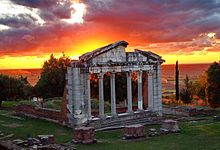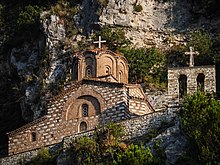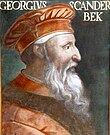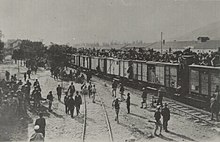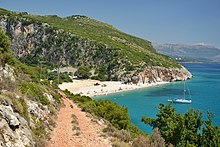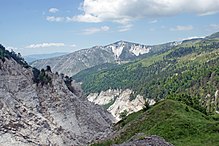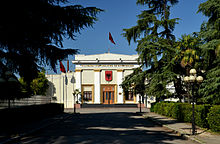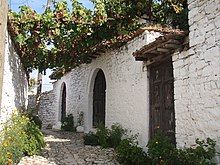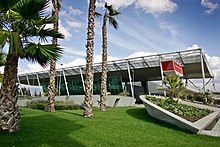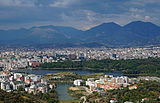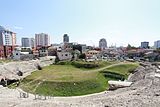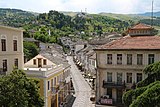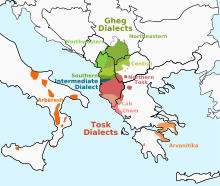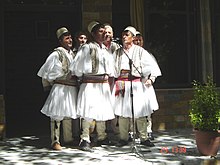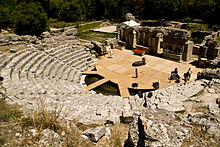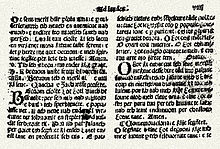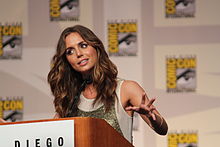In Urdu & Hindi | البانیا کی سیر
Albania (/ælˈbeɪniə, ɔːl-/ ( listen) a(w)l-BAY-nee-ə; Albanian: Shqipëri/Shqipëria; Gheg Albanian: Shqipni/Shqipnia or Shqypni/Shqypnia),[6] officially the Republic of Albania (Albanian: Republika e Shqipërisë, pronounced [ɾɛpuˈblika ɛ ʃcipəˈɾiːsə]), is a country in Southern and Southeastern Europe. It spans 28,748 square kilometres (11,100 square miles) and had a total population of 3 million people as of 2016. Albania is a unitary parliamentary constitutional republic with the capital in Tirana, the country's most populous city and main economic and commercial centre, followed by Durrës. The country's other major cities include Vlorë, Sarandë, Shkodër, Berat, Korçë, Gjirokastër and Fier.
listen) a(w)l-BAY-nee-ə; Albanian: Shqipëri/Shqipëria; Gheg Albanian: Shqipni/Shqipnia or Shqypni/Shqypnia),[6] officially the Republic of Albania (Albanian: Republika e Shqipërisë, pronounced [ɾɛpuˈblika ɛ ʃcipəˈɾiːsə]), is a country in Southern and Southeastern Europe. It spans 28,748 square kilometres (11,100 square miles) and had a total population of 3 million people as of 2016. Albania is a unitary parliamentary constitutional republic with the capital in Tirana, the country's most populous city and main economic and commercial centre, followed by Durrës. The country's other major cities include Vlorë, Sarandë, Shkodër, Berat, Korçë, Gjirokastër and Fier.
Albania occupies the southwestern portion of the Balkan Peninsula, bordered by Montenegro to the northwest, Kosovo[b] to the northeast, the Republic of Macedonia to the east, and Greece to the south and southeast. The country features notable diversity with the landscape ranging from the Albanian Alps in the north, Korab Mountains in the east, Ceraunian Mountains in the south and Skanderbeg Mountains in the center. It has a coastline on the northern shore of the Mediterranean Sea; the Adriatic Sea to the west and the Ionian Sea to the southwest, forming the Albanian Riviera. Albania is less than 72 km (45 mi) from Italyacross the Strait of Otranto which connects the Adriatic Sea to the Ionian Sea.
Albania is a democratic and developing country with an upper-middle income economy. The service sector dominates the country's economy, followed by the industrial and agriculture sector.[9] Following the collapse of communism in 1990, Albania went through a process of transition from a centralized economy to a market-based economy.[10][11][12] Albania has a high Human Development Index and is ranked thirty-seventh in the world for life expectancy. It provides universal health care and free primary and secondary education to its citizens.[5] Albania is a member of the United Nations, World Bank, UNESCO, NATO, WTO, CoE, OSCE and OIC. It is also an official candidate for membership in the European Union.[13] Furthermore, Albania is one of the founding members of the Energy Community, including the Organization of the Black Sea Economic Cooperation, and Union for the Mediterranean.
Etymology
The term Albania is the medieval Latin name of the country. It may be derived from the Illyrian tribe of Albani (Albanian: Albanët) recorded by Ptolemy, the geographer and astronomer from Alexandria, who drafted a map in 150 AD, which shows the city of Albanopolis located northeast of the city of Durrës.[14][15] The term may have a continuation in the name of a medieval settlement called Albanon or Arbanon, although it is not certain that this was the same place.[16] In his history written in the 10th century, the byzantine historian Michael Attaliates was the first to refer to Albanoi as having taken part in a revolt against Constantinoplein 1043 and to the Arbanitai as subjects of the Duke of Dyrrachium.[17] During the Middle Ages, the Albanians called their country Arbëri or Arbëni and referred to themselves as Arbëreshë or Arbëneshë.[18][19]
Nowaday, Albanians call their country Shqipëri or Shqipëria. As early as the 17th century the placename Shqipëria and the ethnic demonym Shqiptarë gradually replaced Arbëria and Arbëresh. The two terms are popularly interpreted as "Land of the Eagles" and "Children of the Eagles".[20][21]
History
Early history
The first traces of human presence in Albania, dating to the Middle Paleolithic and Upper Paleolithic eras, were found in the village of Xarrë, near Sarandë and Mount Dajt near Tiranë.[22] The objects found in a cave near Xarrë include flint and jasper objects and fossilized animal bones, while those found at Mount Dajt comprise bone and stone tools similar to those of the Aurignacian culture. The Paleolithic finds of Albania show great similarities with objects of the same era found at Crvena Stijena in Montenegro and north-western Greece.[22]
Several Bronze Age artefacts from tumulus burials have been unearthed in central and southern Albania that show close connection with sites in south-western Macedonia and Lefkada, Greece. Archaeologists have come to the conclusion that these regions were inhabited from the middle of the third millennium BC by Indo-European people who spoke a Proto-Greek language. A part of this population later moved to Mycenae around 1600 BC and founded the Mycenaean civilisationthere.[23][24][25] Another population group, the Illirii, probably the southernmost Illyrian tribe of that time[26] that lived on the border of Albania and Montenegro, possibly neighbored the Greek tribes.[26][27]
In ancient times, the territory of modern Albania was mainly inhabited by a number of Illyrian tribes. This territory was known as Illyria, corresponding roughly to the area east of the Adriatic sea to the mouth of the Vjosë river in the south.[28][29] The first account of the Illyrian groups comes from Periplus of the Euxine Sea, an ancient Greek text written in the middle of the 4th century BC.[30] The south was inhabited by the Greek tribe of the Chaonians,[31] whose capital was at Phoenice, while numerous colonies, such as Apollonia, Epidamnos and Amantia, were established by Greek city-states on the coast by the 7th century BC.[32]
One of the most powerful tribes that ruled over modern Albania was the Ardiaei. The Ardiaean Kingdom reached its greatest extent under Agron, son of Pleuratus II. Agron extended his rule over other neighboring tribes as well.[33] After Agron's death in 230 BC, his wife Teuta inherited the Ardiaean kingdom. Teuta's forces extended their operations further southward into the Ionian Sea.[34] In 229 BC, Rome declared war[35] on Illyria for extensively plundering Roman ships. The war ended in Illyrian defeat in 227 BC. Teuta was eventually succeeded by Gentius in 181 BC.[36] Gentius clashed with the Romans in 168 BC, initiating the Third Illyrian War. The conflict resulted in Roman victory and the end of Illyrian independence by 167 BC. After his defeat, the Roman split the region into three administrative divisions.[37]
Middle Ages
During the medieval period, the area what is now known as Albania, remained under Byzantine control until the Slavs began to overrun the country from the 7th century.[38] Later it was captured by the Bulgarian Empire in the 9th century. After the weakening of the Byzantine Empire and the Bulgarian Empire in the 13th century, some of the territory of modern Albania was captured by the Serbian Principality. In general, the invaders destroyed or weakened Roman and Byzantine cultural centers in the lands, that would become Albania.[39]
The territorial nucleus of the Albanian state formed in the Middle Ages, as the Principality of Arbër and the Kingdom of Albania. The Principality of Arbër or Albanon (Arbër or Arbëria), was the first Albanian entiy during the Middle Ages, it was established by archon Progon (Progoni i Krujës) in the region of Krujë, in 1190. Progon, was succeeded by his sons Gjin and Dhimitri, the latter which attained the height of the realm. After the death of Dhimiter, the last of the Progon family, the principality came under the Greek Gregory Kamonas[40][41] Lord of Krujë,[42] and later Golem. The Principality was dissolved in 1255.[43][44][45] Pipa and Repishti conclude that Arbanon was the first sketch of an "Albanian state", and that it retained semi-autonomous status as the western extremity of an empire (under the Doukai of Epirus or the Laskarids of Nicaea).[46]
The Kingdom of Albania (Mbretëria e Arbërisë) was established by Charles of Anjou (Karli Anzhu) in the Albanian territory. In 1271, he conquered from the Despotate of Epirus. One year later in February 1272, he took the title of King of Albania. The kingdom extended from the region of Dyrrhachium (modern Durrës), south along the coast to Butrint. After the creation of the kingdom, a catholic political structure was a basis for the papal plans of spreading Catholicism in the Balkans. This plan found also the support of Helen of Anjou, a cousin of Charles of Anjou, who was at that time ruling territories in North Albania. Around 30 catholic churches and monasteries were built during her rule in North Albania and also in Serbia.[47] From 1331 to 1355, the Serbian Empire wrestled control over Albania. After the dissolution of the Serbian Empire, several Albanian principalities were created, and among the most powerful were the Balsha, Thopia, Kastrioti, Muzaka and Arianiti. In the first half of the 14th century, the Ottoman Empire invaded most of Albania. In 1444, the Albanian principalities were united under George Castrioti Skanderbeg (Gjergj Kastrioti Skënderbeu), who became the national hero of the Albanian medieval history.
At the dawn of the establishment of the Ottoman Empire in southeastern Europe, the geopolitical landscape was marked by scattered kingdoms of small principalities. The Ottomans erected their garrisons throughout southern Albania in 1415 and occupied most of the country in 1431.[48] However, in 1443 a great and longstanding revolt broke out under the lead of the Albanian national hero George Castrioti Skanderbeg (Gjergj Kastrioti Skënderbeu), which lasted until 1479, many times defeating major Ottoman armies led by the sultans Murad II and Mehmed II. Skanderbeg united initially the Albanian princes, and later on established a centralized authority over most of the non-conquered territories, becoming the ruling Lord of Albania. He also tried relentlessly but rather unsuccessfully to create a European coalition against the Ottomans. He thwarted every attempt by the Turks to regain Albania, which they envisioned as a springboard for the invasion of Italy and western Europe. His unequal fight against the mightiest power of the time, won the esteem of Europe as well as some support in the form of money and military aid from Naples, Venice, Ragusa and the Papacy.[49]With the arrival of the Ottomans, Islam was introduced in the country as a third religion. This conversion caused a massive emigration of Albanians to other Christian European countries, especially the Arbëreshë of Italy.[50] Along with the Bosniaks, Muslim Albanians occupied an outstanding position in the Ottoman Empire, and were the main pillars of Ottoman Porte's policy in the Balkans.[51]
Enjoying this privileged position in the empire, Muslim Albanians held various high administrative positions, with over two dozen Grand Viziers of Albanian origin, such as Gen. Köprülü Mehmed Pasha, who commanded the Ottoman forces during the Ottoman-Persian Wars; Gen. Köprülü Fazıl Ahmed, who led the Ottoman armies during the Austro-Turkish War; and later Muhammad Ali Pasha of Egypt.[52]
During the 15th century, when the Ottomans were gaining a firm foothold in the region, Albanian towns were organised into four principal sanjaks. The government fostered trade by settling a sizeable Jewish colony of refugees fleeing persecution in Spain (at the end of the 15th century). The city of Vlorë saw passing through its ports imported merchandise from Europe such as velvets, cotton goods, mohairs, carpets, spices, and leather from Bursa and Constantinople. Some citizens of Vlorë even had business associates throughout Europe.[52]
Albanians could also be found throughout the empire in Iraq, Egypt, Algeria and across the Maghreb, as vital military and administrative retainers.[53] This was partly due to the Devşirme system. The process of Islamization was an incremental one, commencing from the arrival of the Ottomans in the 14th century (to this day, a minority of Albanians are Catholic or Orthodox Christians, though the vast majority became Muslim). Timar holders, the bedrock of early Ottoman control in southeast Europe, were not necessarily converts to Islam, and occasionally rebelled; the most famous of these rebels is Skanderbeg (his figure would rise up later on, in the 19th century, as a central component of the Albanian national identity). The most significant impact on the Albanians was the gradual Islamisation process of a large majority of the population, although it became widespread only in the 17th century.[51]
Mainly Catholics converted in the 17th century, while the Orthodox Albanians followed suit mainly in the following century. Initially confined to the main city centres of Elbasan and Shkodër, by this period the countryside was also embracing the new religion. The motives for conversion according to some scholars were diverse, depending on the context. The lack of source material does not help when investigating such issues.[51] Albania remained under Ottoman control as part of the Rumelia province until 1912, when independent Albania was declared.
Modern
The National Renaissance (Rilindja Kombëtare) began in the 1870s and lasted until 1912, when the Albanians declared their independence. The League of Prizren(League for the Defense of the Rights of the Albanian Nation) (Lidhja e Prizrenit) was formed on June 1878, in the old town of Prizren, Kosovo Vilayet. At first the Ottoman authorities supported the League, whose initial position was based on the religious solidarity of Muslim landlords and people connected with the Ottoman administration. The Ottomans favoured and protected the Muslim solidarity, and called for defense of Muslim lands, including present-day Bosnia and Herzegovina. This was the reason for naming the league 'The Committee of the Real Muslims' (Komiteti i Myslimanëve të Vërtetë).[54] The League issued a decree known as Kararname. Its text contained a proclamation that the people from northern Albania, Epirus and Bosnia" are willing to defend the 'territorial integrity' of the Ottoman Empire by all possible means against the troops of the Bulgarian, Serbian and Montenegrin Kingdoms. However, it was signed by 47 Muslim deputies of the League on June 18, 1878.[55] Around 300 Muslims participated in the assembly, including delegates from Bosnia and mutasarrif (sanjakbey) of the Sanjak of Prizren as representatives of the central authorities, and no delegates from Scutari Vilayet.[56]
The Ottomans cancelled their support when the League, under the influence of Abdyl Bey Frashëri, became focused on working toward the Albanian autonomy and requested merging of four Ottoman vilayets, which includes Kosovo, Scutari, Monastir and Ioannina into a new vilayet of the Ottoman Empire, the Albanian Vilayet. The League used military force to prevent the annexing areas of Plav and Gusinje assigned to Montenegro by the Congress of Berlin. After several successful battles with Montenegrin troops such as in Novsice, under the pressure of the great powers, the League of Prizren was forced to retreat from their contested regions of Plav and Gusinje and later on, the league was defeated by the Ottoman army sent by the Sultan.[57] The Albanian uprising of 1912, the Ottoman defeat in the Balkan Wars and the advance of Montenegrin, Serbian and Greek forces into territories claimed as Albanian, led to the proclamation of independence by Ismail Qemali in southern Vlorë, on November 28, 1912.
At the All-Albanian Congress in southern Vlorë on 28 November 1912, the participants constituted the Assembly of Vlorë.[58][59] The assembly of eighty-three leaders, declared the nation as an independent country and set up a provisional government. The Provisional Government was established on the second session of the assembly on 4 December 1912. Furthermore, it was a government of ten members led by Ismail Qemali, until his resignation on 22 January 1914.[60] However the Assembly also established the Senate (Pleqësi), with an advisory role to the government, consisting of 18 members of the Assembly.[61]
The independence of Albania was recognized by the Conference of London on 29 July 1913. The drawing of the borders of the newly established Principality of Albaniaignored the demographic realities of the time. The International Commission of Control was established on 15 October 1913 to take care of the administration of newly established Albania, until its own political institutions were in order.[62] Its headquarters were in Vlorë.[63] The International Gendarmerie was established as the first law enforcement agency of the Principality of Albania. In November, the first gendarmerie members arrived in the country. Prince of Albania Wilhelm of Wied (Princ Vilhelm Vidi) was selected as the first prince of the principality.[64] On 7 March, he arrived in the provisional capital of Durrës and started to organise his government, appointing Turhan Pasha Përmeti to form the first Albanian cabinet.
In November 1913, the Albanian pro-Ottoman forces had offered the throne of Albania to the Ottoman war Minister of Albanian origin, Ahmed Izzet Pasha.[65] The pro-Ottoman peasants believed that, the new regime of the Principality of Albania was a tool of the six Christian Great Powers and local landowners, that owned half of the arable land.[66]
In February 1914, the Autonomous Republic of Northern Epirus was proclaimed in Gjirokastër by the local Greek population against incorporation to Albania. This initiative was short lived and in 1921, the southern provinces were finally incorporated to the Albanian Principality.[67][68] Meanwhile, the revolt of Albanian peasantsagainst the new Albanian regime erupted under the leadership of the group of Muslim clerics gathered around Essad Pasha Toptani, who proclaimed himself the savior of Albania and Islam.[69][70] In order to gain support of the Mirdita Catholic volunteers from the northern part of Albania, Prince Wied appointed their leader, Prênk Bibë Doda, to be the foreign minister of the Principality of Albania. In May and June 1914, the International Gendarmerie was joined by Isa Boletini and his men, mostly from Kosovo,[71] and northern Mirdita Catholics, were defeated by the rebels who captured most of Central Albania by the end of August 1914.[72] The regime of Prince Wiedcollapsed and later he left the country on 3 September 1914.[73]
First Republic
The short-lived principality (1914–1925) was succeeded by the first Albanian Republic (1925–1928). In 1925 the four-member Regency was abolished and Ahmed Zoguwas elected president of the newly declared republic. Tirana was endorsed officially as the country's permanent capital.[74] Zogu led an authoritarian and conservative regime, the primary aim of which was the maintenance of stability and order. Zogu was forced to adopt a policy of cooperation with Italy. A pact had been signed between Italy and Albania on 20 January 1925 whereby Italy gained a monopoly on shipping and trade concessions.[75]
The Albanian republic was eventually replaced by another monarchy in 1928. In order to extend his direct control throughout the entire country, Zogu placed great emphasis on the construction of roads. Every male Albanian over the age of 16 years was legally bound to give ten days of free labor each year to the state.[75] King Zogu remained a conservative, but initiated reforms. For example, in an attempt at social modernization, the custom of adding one's region to one's name was dropped. Zogu also made donations of land to international organisations for the building of schools and hospitals. The armed forces were trained and supervised by Italian instructors. As a counterweight, Zogu kept British officers in the Gendarmerie despite strong Italian pressure to remove them. The kingdom was supported by the fascist regime in Italy and the two countries maintained close relations until Italy's sudden invasion of the country in 1939. Albania was occupied by Fascist Italy and then by Nazi Germany during World War II.
After being militarily occupied by Italy, from 1939 until 1943 the Albanian Kingdom was a protectorate and a dependency of Italy governed by the Italian King Victor Emmanuel III and his government. After the Axis' invasion of Yugoslavia in April 1941, territories of Yugoslavia with substantial Albanian population were annexed to Albania: most of Kosovo,[b] as well as Western Macedonia, the town of Tutin in Central Serbia and a strip of Eastern Montenegro.[76] In November 1941, the small Albanian Communist groups established an Albanian Communist Party in Tirana of 130 members under the leadership of Enver Hoxha and an eleven-man Central Committee. The party at first had little mass appeal, and even its youth organization netted few recruits.
After the capitulation of Italy in 1943, Nazi Germany occupied Albania too. The nationalist Balli Kombetar, which had fought against Italy, formed a "neutral" government in Tirana, and side by side with the Germans fought against the communist-led National Liberation Movement of Albania.[77] The Center for Relief to Civilian Populations (Geneva) reported that Albania was one of the most devastated countries in Europe. 60,000 houses were destroyed and about 10% of the population was left homeless. The communist partisans had regrouped and gained control of much of southern Albania in January 1944. However, they were subject to German attacks driving them out of certain areas. In the Congress of Përmet, the NLF formed an Anti-Fascist Council of National Liberation to act as Albania's administration and legislature. By the last year in World War II Albania fell into a civil war-like state between the communists and nationalists. The communist partisans however defeated the last Balli Kombëtar forces in southern Albania by mid-summer 1944. Before the end of November, the main German troops had withdrawn from Tirana, and the communists took control by attacking it. The partisans entirely liberated Albania from German occupation on 29 November 1944. A provisional government, which the communists had formed at Berat in October, administered Albania with Enver Hoxha as prime minister.
Communism
By the end of the second World War, the main military and political force of the nation, the Communist party sent forces to northern Albania against the nationalists to eliminate its rivals. They faced open resistance in Nikaj-Mërtur, Dukagjin and Kelmend led by Prek Cali.[78] On 15 January 1945, a clash took place between partisans of the first Brigade and nationalist forces at the Tamara Bridge, resulting in the defeat of the nationalist forces. About 150 Kelmendi[79][page needed] people were killed or tortured. This event was the starting point of many other issues which took place during Enver Hoxha's dictatorship. Class struggle was strictly applied, human freedom and human rights were denied.[80] The Kelmend region was almost isolated by both the border and by a lack of roads for another 20 years, the institution of agricultural cooperatives brought about economic decline. Many Kelmendi people fled, some were executed trying to cross the border.[80]
After the liberation of Albania from the Nazi occupation, the country became a Communist state. Afterwards, the People's Republic of Albania (renamed "People's Socialist Republic of Albania" in 1976) was founded, which was led by Enver Hoxha and the Labour Party of Albania.[81] The socialist reconstruction of Albania was launched immediately after the annulling of the monarchy and the establishment of a People's Republic. In 1947, Albania's first railway line was completed, with the second one being completed eight months later. New land reform laws were passed granting ownership of the land to the workers and peasants who tilled it. Agriculture became cooperative, and production increased significantly, leading to Albania's becoming agriculturally self-sufficient. By 1955, illiteracy was eliminated among Albania's adult population.[82]
During this period, Albania became industrialized and saw rapid economic growth, as well as unprecedented progress in the areas of education and health care.[80] The average annual increase in Albania's national income was 29% higher than the world average and 56% higher than the European average.[84][not in citation given]. The nation incurred large debts, first with Yugoslavia until 1948, then the Soviet Union until 1961, and China from the middle of the 1950s.[85] The communist constitution did not allow taxes on individuals; instead, taxes were imposed on cooperatives and other organizations, with much the same effect.[86] Religious freedoms were severely curtailed during the communist regime, with all forms of worship being outlawed. In August 1945, the Agrarian Reform Law meant that large swaths of property owned by religious groups (mostly Islamic waqfs) were nationalized, along with the estates of monasteries and dioceses. Many believers, along with the ulema and many priests, were arrested and executed. In 1949, a new Decree on Religious Communities required that all their activities be sanctioned by the state alone.[87]
After hundreds of mosques and dozens of Islamic libraries, containing priceless manuscripts, were destroyed, Enver Hoxha proclaimed Albania the "World's first atheist state" in 1967.[88][89] The churches had not been spared either, and many were converted into cultural centers for young people. A 1967 law banned all "fascist, religious, warmongerish, antisocialist activity and propaganda". Preaching religion carried a three to ten-year prison sentence. Nonetheless, many Albanians continued to practice their beliefs secretly. The Hoxha dictatorship's anti-religious policy attained its most fundamental legal and political expression a decade later: "The state recognizes no religion," states Albania's 1976 constitution, "and supports and carries out atheistic propaganda in order to implant a scientific materialistic world outlook in people."[89] Enver Hoxha's political successor, Ramiz Alia oversaw the dismemberment of the "Hoxhaist" state during the collapse of the Eastern Bloc in the late 1980s.
Fourth Republic
After the revolution of 1989, reforms were made by the communist government in 1990. Subsequently, the People's Republic was dissolved and the 4th Albanian Republic was founded on 29 April 1991. The communists retained a stronghold in the Parliament, after popular support in the first multi-party elections in 1991. In March 1992, amid liberalization policies resulting in economic collapse and social unrest, a new coalition led by the new Democratic Party took power after victory in the parliamentary elections of 1992.
In the following years, much of the accumulated wealth of the country was invested in Ponzi pyramid banking schemes, which were widely supported by the government. The schemes swept up somewhere between one sixth and one third of the Albanian population.[90][91] Despite the International Monetary Fund (IMF) warnings in late 1996, President Sali Berisha defended the schemes as large investment firms, leading more people to redirect their remittances and sell their homes and cattle for cash to deposit in the schemes.[92] The schemes began to collapse in late 1996, leading many of the investors to join initially peaceful protests against the government, requesting their money back. The protests turned violent in February 1997 as government forces responded with fire. In March, the Police and Republican Guard deserted, leaving their armories open. These were promptly emptied by militias and criminal gangs. The resulting crisis caused a wave of evacuations of foreign nationals and of refugees.[93]
The crisis led Prime Minister Aleksandër Meksi to resign on 11 March 1997, followed by President Sali Berisha in July in the wake of the June General Election. In April 1997, Operation Alba, a UNpeacekeeping force led by Italy, entered the country with two goals: to assist with the evacuation of expatriates and to secure the ground for international organizations. The main international organization involved was the Western European Union's Multinational Albanian Police element (MAPE), which worked with the government to restructure the judicial system and the Albanian Police. The Socialist Party had won the previously mentioned parliamentary elections in June 1997, and a degree of political stabilization followed. In 1999, the country was affected by the Kosovo War, which caused a great number of ethnic Albanians from Kosovo to seek refuge in Albania, although most ultimately returned to Kosovo.
On 23 June 2013, the eighth parliamentary elections took place, won by Edi Rama of the Socialist Party. During his tenure as 33rd Prime Minister, Albania has implemented numerous reforms focused on the modernizing the economy and democratizing of state institutions like the judiciary and law enforcement. Additionally, unemployment has been steadily reduced to the 4th lowest unemployment rate in the Balkans.[94]
After the collapse of the Eastern Bloc, Albania started to develop closer ties with Western Europe. At the 2008 Bucharest summit, the North Atlantic Treaty Organization (NATO) invited Albania to join the alliance. In April 2014 Albania became a full member of NATO. Albania was among the first southeastern European countries to join the Partnership for peace programme. Albania applied to join the European Union, becoming an official candidate for accession to the European Union in June 2014. Although Albania received candidate status for the European Union membership in 2014 (based on its 2009 application), the European Union has twice rejected full membership.[95] The European Parliament warned the Government leaders in early 2017 that the 2017 parliamentary elections in June must be free and fair before negotiations could begin to admit the country into the union.[96][97]
Geography
Albania occupies the southwestern portion of the Balkan Peninsula. It is located in Southeastern and Southern Europe, with Montenegro bordering to the northwest, Kosovo to the northeast, Macedonia to the east and Greece to the south. The Adriatic and Ionian Seas make up the entire west border of Albania. It lies mostly between latitudes 42° and 39° N, and longitudes 21° and 19° E. The territory covers 28,748 square kilometres (11,100 square miles), making it the 145th largest country in the world. Albania's coastline length is 476 km (296 mi) and extends along the Adriatic and Ionian Seas within the Mediterranean Sea.[98]:240
Albania's northernmost point is Vërmosh at 42° 35' 34" northern latitude; the southernmost is Konispol at 39° 40' 0" northern latitude; the westernmost point is Sazan Island at 19° 16' 50" eastern longitude; and the easternmost point is Vërnik at 21° 1' 26" eastern longitude.[99] The highest point is Mount Korab standing at 2,764 metres (9,068 ft) above sea level, and the lowest is the Mediterranean Sea. The distance from east to west is 148 kilometres (92 mi), from north to south 340 kilometres (211 mi).
Despite its small size, Albania is dominated by mountainous or high terrain, with a wide variety of natural features including valleys, plains, canyons and caves. Topographically, the mountains run the length of the country from north to south; the Albanian Alps in the north, Sharr Mountains in the northeast, Skanderbeg Mountains in the center, Korab Mountains in the east, Pindus Mountains in the southeast and the Ceraunian Mountains in the southwest along the Albanian Riviera.
The hydrographic network of Albania includes several of the largest and most ancient bodies of fresh water in Southern Europe. Lake Shkodër is the largest lake, situated in the northwest with a surface which can vary between 370 km2 (140 sq mi) and 530 km2 (200 sq mi), out of which one third belongs to Albania and the rest to Montenegro.[100] It is the largest lake in Southern Europe. Lake Ohrid in the southeast is shared with Macedonia and is one of the most ancient lakes in the world.[101][102] Lake Prespa at the border triangle with Macedonia and Greece is one the highest tectonic lakes within the Balkan Peninsula at an elevation of 853 metres (2,799 ft). Albania has a dense network of about 152 rivers and streams, forming at least 8 large rivers, which flow from east to west towards the Adriatic Sea. Among which are included Drin, Vjosë, Shkumbin, Osum, Mat, Erzen, Fan and Seman.
Biodiversity
Although a small country, Albania is distinguished by a high biodiversity. Due to its climatic, hydrological and geological conditions, it is host to 30% of the entire floraand 42% of fauna of Europe.[103][104] In terms of phytogeography, Albania straddles the Illyrian province of the Circumboreal Region within the Boreal Kingdom. The country falls within four terrestrial ecoregions of the Palearctic ecozone, including the Illyrian deciduous forests, Balkan mixed forests, Pindus Mountains mixed forests, and Dinaric Alpine mixed forests.[105] The country's biodiversity is conserved in 14 national parks, 1 marine park, 4 ramsar sites, 1 biosphere reserve, 45 important plant areas, 16 important bird areas and 786 protected areas of various caterogies.
About 10,000 square kilometres (3,861 square miles) of the country's territory are forested and very rich in flora. About 3,000 different species of plants can be found, many of which are used for medicinal purposes. The coastal regions and lowlands have typical Mediterranean macchia vegetation, whereas oak forests and vegetation are found at higher elevations. Vast forests of pine, beech and fir are found on higher mountains such as in the Albanian Alps and Korab Mountains. Alpine grasslandsgrow at elevations above 1,800 metres (5,900 feet).[106]
The forests of the country are home to a wide range of mammals. Wolves, red foxes, bears, wild boars and chamois are the primary predatory mammals.[106] Lynx, wildcats, pine martens and polecats are rare, but survive in various forests throughout the country.[107] There are around 760 vertebrate species found so far in Albania. Among them there are over 350 birdspecies, 330 fish species and 80 mammal species. There are some 91 globally threatened species found within the country, among them the dalmatian pelican, pygmy cormorant and european sea sturgeon. The rocky coastal regions in the south provide good habitats for the endangered mediterranean monk seal. Some of the most significant bird species found in the country include the golden eagle (national symbol of Albania), various vulture species, capercaillie and waterfowl species.[108]
Climate
According to the Köppen system, Albania hosts five major climatic subtypes. These include mediterranean, subtropical, oceanic, continental and subarctic. With its coastline facing the Adriatic Sea and Ionian Sea in the west, Albania's highlands backed upon the elevated Balkan landmass, and the entire country lying at a latitude subject to a variety of weather patterns during the winter and summer seasons. The climate on the coasts is typically mediterranean, while in the highlands it is continental. In both the western lowlands and the inner highlands, the weather varies from north to south. The lowlands have mild winters, averaging about 7 °C (45 °F), while summer temperatures average 24 °C (75 °F). In the southern lowlands, temperatures average about 5 °C (9 °F) higher throughout the year. The difference is greater than 5 °C (9 °F) during the summer and somewhat less during the winter.
Inland conditions vary depending on elevation, but the higher areas above 1,524 metres (5,000 feet) in the northern and central highlandsare rather cold and frequently snowy in winter; here cold conditions with snow may linger into spring. The temperatures are affected more by differences in elevation than by latitude or any other factor. Average summer temperatures are lower than in the coastal areas and much lower at higher elevations, but daily fluctuations are greater.
Average precipitation is heavy, a result of the convergence of the prevailing airflow from the Mediterranean Sea and the continental air mass.Because they usually meet at the point where the terrain rises, the heaviest rain falls in the central highlands. When the continental air mass is weak, Mediterranean winds drop their moisture farther inland. When there is a dominant continental air mass, cold air spills onto the lowland areas, which occurs most frequently in the winter.
Lowland rainfall averages from 1,000 millimeters (39.4 in) to more than 1,500 millimeters (59.1 in) annually, with the higher levels in the north. Nearly 95% of the rain falls in the winter. Rainfall in the northern highlands is heavier. Adequate records are not available, and estimates vary widely, but annual averages are probably about 1,800 millimeters (70.9 in) and are as high as 2,550 millimeters (100.4 in). However, the western Albanian Alps are among the wettest areas in Europe, receiving some 3,100 mm (122.0 in) of rain annually.[109] The seasonal variation is not quite as great in the coastal area. The central highlands receive less precipitation than the intermediate northern highlands. Terrain differences cause wide local variations, but the seasonal distribution is the most consistent of any area. In 2009, an expedition from the University of Colorado discovered four small glaciers inside the Albanian Alps. The glaciers are at the relatively low level of 2,000 metres (6,600 ft), almost unique for such a southerly latitude.[110]
Administrative divisions
With a total area of 28,748 square kilometres (11,100 square miles), Albania is divided into 12 counties (Albanian: Qarqe). The counties are the primary administrative divisions and further subdivided into 61 municipalities (Bashkia). Until 2000, the 12 counties were subdivided into 36 districts (Rrethe).[111]
The counties were created on 31 July 2000 to replace the 36 former districts.[112] The government introduced the new administrative divisions to be implemented in 2015, whereby municipalities were reduced to 61, while the rurals (Komuna) were abolished. The defunct municipalities are known as neighborhoods or villages (Lagje or Fshat).[113][114] There are overall 2980 villages or communities in the entire country, formerly known as localities (Lokalitete). The municipalities are the first level of local governance, responsible for local needs and law enforcement.[115] As part of the reform, major town centers in the country were physically redesigned and façades painted to reflect a more Mediterranean look.[116][117]
| ||||||||||||||||||||||||||||||||||||||||||||||||||||||||||||||||||||
Politics
Politics in Albania operate under a framework laid out in the Constitution of Albania. First in 1913, Albania was constituted as a monarchy, briefly a republic in 1920, then into a democratic monarchy in 1928. Succeeding, it became a socialist republic, until the restoration of capitalism and democracy, after the collapse of communism. Nowadays, Albania is a unitary parliamentary constitutional republic in which the President serves as the head of state and the Prime Minister as the head of government.[118]
The President is the head of state, commander-in-chief of the military and the representative of the unity of the Albanian people.[119]The head of state is elected to a five-year term by the Parliament by a majority of three-fifths of all its members. The President has the power to guarantee observation of the Constitution and all laws, exercise the duties of the Parliament when it is not in session and appoints the Prime Minister. The executive power is exercised by the head of government and the Council of Ministers which make up the government. The Parliament must give final approval of the composition of the Cabinet. The Prime Minister is responsible for carrying out both foreign and domestic policies, directs and controls the activities of the ministries and other state organs.
The Parliament is the unicameral representative body of the citizens of Albania and is elected by the people to a four-year term on the basis of direct, universal, periodic and equal suffrage by secret ballot. There are 140 deputies in the Parliament, which are elected through a party-list proportional representation system. The Parliament has the power to decide the direction of domestic and foreign policy, approve or amend the constitution, declare war on another state, ratify or annul international treaties, elect the President, the Supreme Court, the Attorney General and their deputies and control the activity of state radio and television, state news agency and other official information media.
The judicial system of Albania is a civil law system divided between courts with regular civil and criminal jurisdiction and administrative courts. It is codified and based on the French law. Major institutions of the branch include the Supreme Court, Constitutional Court, Court of Appeal, and the Administrative Court. Law enforcement in the country is primarily the responsibility of the Albanian Police. It is the main and largest state law enforcement agency in the country. It carries nearly all general police duties thath includes criminal investigation, patrol activity, traffic policing and border control.
Foreign relations
Foreign relations are conducted through the Ministry of Foreign Affairs in Tirana. The current minister is Ditmir Bushati. Since the collapse of Communism in 1990, Albania has extended its responsibilities and position in European and international affairs, supporting and establishing friendly relations with other nations around the world.
The main objectives of the Albanian foreign policy are the Accession of Albania to the European Union, the International recognition of Kosovo, the recognition of Expulsion of Cham Albanians,[120] helping and protecting of the rights the Albanians in Montenegro, Macedonia, Greece, southern Serbia, Italy and the Albanian diaspora. Albania has a network of 40 foreign embassies and 46 diplomatic missions abroad.
Albania has been a member of the United Nations since December 1955. Three years later in 1958, it became member of UNESCO. Albania took on the membership of the United Nations Economic and Social Council from 2005 to 2007 and for the second time in 2012.[121] In addition to that, Albania served as vice president of the ECOSOC in 2006 and 2013.[121] In 2014, it also joined the United Nations Human Rights Council from 2015 to 2017 and was elected vice president in 2015.[122] Albania was among the first eastern European countries to join the North Atlantic Treaty Organization (NATO). Major Albanian politicians considered admission to NATO as a top priority for the country. Since 1992, it has been extensively engaged with NATO, and has maintained its position as a stability factor and a strong ally of the United States and European Union in the troubled and divided region of the Balkans.
Besides, Albania is a full member of numerous international organizations, namely the United Nations, Council of Europe, International Organization for Migration, World Health Organization, Union for the Mediterranean, Organisation of Islamic Cooperation, Organization for Security and Cooperation in Europe, International Monetary Fund, World Trade Organization and La Francophonie.
Military
The Albanian Armed Forces (Forcat e Armatosura të Shqipërisë) are the military and paramilitary forces of Albania, under the President as supreme commander. In times of peace, the President's powers as a commander are executed through the Prime Minister and the Defence Minister.[123] The military consist the General staff, the Land Force (Forca Tokësore), the Air Force (Forca Ajrore) and the Naval Force (Forca Detare). Albania has nocompulsory military service.[124] Until January 2010 military service was compulsory for men at age 18 and conscripts served six-month tours of duty. Nowadays, military service is voluntary, with the age of 19 being the legal minimum age for the duty.[125]
Albania has committed to increase the participations in multinational operations.[126] Since the fall of communism, the country has participated in six international missions but participated in only one United Nations mission in Georgia sending of 3 military observers. Since February 2008, Albania has participated officially in NATO's Operation Active Endeavor in the Mediterranean Sea.[127] It was invited to join NATO on 3 April 2008, and it became a full member on 2 April 2009.[128]
Albania reduced the number of active troops from 65,000 in 1988 to 14,500 in 2009.[129][130] The military now consists mainly of a small fleet of aircraft and sea vessels. In the 1990s, the country scrapped enormous amounts of obsolete hardware from China, such as tanks and SAM systems. Increasing the military budget was one of the most important conditions for NATO integration. Military spending has generally been low. As of 1996 military spending was an estimated 1.5% of the country's GDP, only to peak in 2009 at 2% and fall again to 1.5%.[131] According to 2016 Global Peace Index, the nation ranked 54th out of 163 countries in the world.
Economy
The transition from a socialist planned economy to a capitalist mixed economy has been largely successful.[132] Albania has a developing mixed economy that is classed as a upper-middle income economy by the World Bank. With 14.7% in 2016, Albania has the 4th lowest unemployment rate in the Balkans. Albania's largest trading partners are Italy, Greece, China, Spain, Kosovo and the United States. The lek (ALL) is Albania's currency and is pegged at approximately 132,51 lek per euro.
Both, Tirana and Durrës are the economic heart of Albania. Further, Tirana is the major centre for trade, banking and finance, transportation, advertising, legal services, accountancy, and insurance. Major roads and railways run through Tirana and Durrës, connecting the north with the south and the west with the east. Among the largest companies the petroleum Taçi Oil, Albpetrol, ARMO and Kastrati, the mineral AlbChrome, THE cement Antea, the investment BALFIN Group and the technology Albtelecom, Vodafone, Telekom Albania and others.
In 2012, Albania's GDP per capita stood at 30% of the European Union average, while GDP (PPP) per capita was 35%.[133] Albania were one of three countries in Europe to record an economic growth in the first quarter of 2010 after the global financial crisis.[134][135] The International Monetary Fund predicted 2.6% growth for Albania in 2010 and 3.2% in 2011.[136] According to the Forbes as of December 2016, the Gross Domestic Product (GDP) was growing at 2.8%. The country had a trade balance of −9.7% and unemployment rate of 14.7%.[137] The Foreign direct investment has increased significantly in recent years as the government has embarked on an ambitious program to improve the business climate through fiscal and legislative reforms. The economy is expected to expand in the near term, driven by a recovery in consumption and robust investments. Growth is projected to be 3.2% in 2016, 3.5% in 2017, and 3.8% in 2018.
Primary sector
Agriculture in the country is based on small to medium-sized family-owned dispersed units. It remains a significant sector of the economy of Albania. It employs 41%[138]of the population, and about 24.31% of the land is used for agricultural purposes. One of the earliest farming sites in Europe has been found in southeastern of the country.[139] As part of the pre-accession process of Albania to the European Union, farmers are being aided through IPA funds to improve Albanian agriculture standards.[140]
Albania produces significant amounts of fruits (apples, olives, grapes, oranges, lemons, apricots, peaches, cherries, figs, sour cherries, plums, and strawberries), vegetables (potatoes, tomatoes, maize, onions, and wheat), sugar beets, tobacco, meat, honey, dairy products, traditional medicine and aromatic plants. Albania's proximity to the Ionian Sea and the Adriatic Sea give the underdeveloped fishing industry great potential. The World Bank and European Community economists report that, Albania's fishing industry has good potential to generate export earnings because prices in the nearby Greek and Italian markets are many times higher than those in the Albanian market. The fish available off the coasts of Albania are carp, trout, sea bream, mussels, and crustaceans.
Albania has one of Europe's longest histories of viticulture.[141] The today's region was one of the few places where vine was naturally grown during the ice age. The oldest found seeds in the region are 4,000 to 6,000 years old.[142] In 2009, the nation produced an estimated 17,500 tonnes of wine[143] During the communism, the production area expanded to some 20,000 hectares (49,000 acres).[144]
Secondary sector
The secondary sector of Albania have undergone many changes and diversification, since the collapse of the communist regime in the country. It is very diversified, from electronics, manufacturing,[145] textiles, to food, cement, mining,[146] and energy. The Antea Cement plant in Fushë-Krujë is considered as one of the largest industrial greenfield investments in the country.[147] Albanian oil and gas is represents of the most promising albeit strictly regulated sectors of its economy. Albania has the second largest oil deposits in the Balkan peninsula after Romania, and the largest oil reserves[148] in Europe. The Albpetrol company is owned by the Albanian state and monitors the state petroleum agreements in the country. The textile industry has seen an extensive expansion by approaching companies from the European Union (EU)in Albania. According to the Institute of Statistics (INSTAT) as of 2016, the textile production marked an annual growth of 5,3% and an annual turnover of around 1,5 billion euros.[149]
Albania is a significant minerals producer and is ranked among the world's leading chromium producers and exporters.[150] The nation is also a notable producer of copper, nickel and coal.[151] The Batra mine, Bulqizë mine, and Thekna mine are among the most recognised Albanian mines that are still in operation.
Tertiary sector
The service industry represents the fastest growing sector of the Albanian economy. A significant part of Albania's national income derives from tourism. In 2016, it directly accounted for 8.4 percent of GDP, though including indirect contributions pushes the proportion to 26 percent.[152] In the same year, Albania welcomed around 4.74 million visitors, mostly from Southern Europe and several countries from the European Union and also the United States.[153] The increase of foreign visitors has been dramatic. Albania had only 500,000 visitors in 2005, while in 2012 had an estimated 4.2 million, an increase of 740 percent in only 7 years. In 2015, tourism in summer increased by 25 percent in contrast the previous year, accouring to the country's tourism agency.[154] In 2011, Lonely Planet named as a top travel destination,[155][not in citation given] while The New York Times placed Albania as number 4 global touristic destination in 2014.[156]
The bulk of the tourist industry is concentrated along the Adriatic and Ionian Sea in the west of the country. However, the Albanian Riviera in the southwest has the most scenic and pristine beaches, and is often called the pearl of the Albanian coast. Its coastline has a considerable length of 446 kilometres (277 miles).[157] The coast has a particular character because it is rich in varieties of virgin beaches, capes, coves, covered bays, lagoons, small gravel beaches, sea caves and many landforms. Some parts of this seaside are very clean ecologically, which represent in this prospective unexplored areas, which are very rare within the Mediterranean.[158] Other attractions include the mountainous areas such as the Albanian Alps, Ceraunian Mountains and Korab Mountains but also the historical cities of Berat, Durrës, Gjirokastër, Sarandë, Shkodër and Korçë.
Infrastructure
Following the collapse of the communist regime in Albania, the transportation has undergone significant changes in the past two decades, vastly modernizing the country's infrastructure. Improvements to the road infrastructure, urban transport, and air travel have all led to a vast improvement in transportation.
Currently there are three main motorways in Albania: the A1, A2, and A3. The A1 motorway connects the port city of Durrës on the Adriatic Sea, to Pristina, the capital of Kosovo. Prospectively, the motorway will link with Pan-European Corridor X near Nišin Serbia. The project was the largest and most expensive infrastructure road project ever undertaken in the country. Two additional highways are currently under construction. The A3 motorway is going to connect the capital city Tirana with Pan-European Corridor VIII, linking Albania with Macedonia and Bulgaria to the east. The North-South motorway consists of SH1and SH2 and makes up the Albanian portion of the Adriatic–Ionian motorway, a larger regional highway connecting Croatia with Greece along the Adriatic and Ionian coasts. When all three corridors are completed, Albania will have an estimated 759 kilometers of highway linking it with all of its neighboring countries.
The busiest and largest seaport in Albania is the Port of Durrës. As of 2014, the port ranks as one of the largest passenger ports on the Adriatic Sea, with annual passenger volume of approximately 1.5 million. Other seaports include Vlorë, Sarandë, and Shëngjin. The ports serve an extensive system of ferries connecting numerous islands and coastal cities in addition to ferry lines to several cities in Croatia, Greece, and Italy.
The only international airport in the country is the Tirana International Airport Nënë Tereza. It is the only port of entry for air travelers to the country. The airport offers international connections to many European cities. In 2016, the Government of Albania reached an agreement with Tirana International Airport to end its monopoly on flights, paving the way for the opening of an airport at Kukës in the north.[159]
The railways in Albania are administered by the national railway company Hekurudha Shqiptare. The railway system was extensively promoted by the totalitarian communist regime of dictator Enver Hoxha, during which time the use of private transport was effectively prohibited. Since the collapse of the communist regime, there has been a considerable increase in car ownership and bus usage. A new railway line from the capital Tirana via Tirana International Airport to the port city Durrës is currently planned. The location of this railway, connecting the most populated urban areas in Albania, makes it an important economic development project.[160] The opening will take place in 2019.[161]
Science and technology
Until 1990, after the fall of Communism in Albania, the country was one of the world's most isolated and controlled countries, and installation and maintenance of a modern system of international and domestic telecommunications was precluded. Callers previously needed operator assistance even to make domestic long-distance calls. Internet in Albania is fast and inexpensive in comparison to the rest of Europe. For example, an ISP known as ABcom, offers a 30mbit download package for 306.999 lekë ($2.39579 USD) per month.[162] In the mobile network industry, providers such as Vodafone, Telekom, Albanian Mobile Communications and Eagle Mobile provide both 3G and 4G data plans. From 1993 human resources in sciences and technology have drastically decreased. Various surveys show that during 1991–2005, approximately 50% of the professors and research scientists of the universities and science institutions in the country have emigrated.[163]
However, in 2009 the government approved the "National Strategy for Science, Technology and Innovation in Albania"[164] covering the period 2009–15. It aims to triple public spending on research and development (R&D) to 0.6% of GDP and augment the share of gross domestic expenditure on R&D from foreign sources, including via the European Union's Framework Programmes for Research, to the point where it covers 40% of research spending, among others.
Energy
Energy in Albania is dependent on hydroelectricity. Albania is the largest producer of hydroelectricity in the world, having a percentage of 100%.[165] The country is host to five hydroelectric power stations and a plant. Almost four power stations including Fierza, Koman, Skavica and Vau i Dejës are situated on the Drin River, the longest river in the country with a total length of 335 km (208 mi). Due to its strategical location, it plays a significant role for the production of electricity in Albania.
Albania and Croatia have discussed the possibility of jointly building a nuclear power plant at Lake Shkodër, close to the border with Montenegro, a plan that has gathered criticism from Montenegro due to seismicity in the area.[166] In February 2009 Italian company Enel announced plans to build an 800 MW coal-fired power plant in Albania, to diversify electricity sources.[167]
The Albanian Devoll Hydropower company, owned and operated by Norwegian Statkraft, is currently build two hydroelectricity plants on the Devoll River near Banjë and Moglicë. The Moglicë Hydro Power Plant is anticipated to be the world's highest of its kind upon completion.[168] The Devoll Hydropower Project is one of the largest hydropower investments in the Balkan peninsula.[169] The two plants are expected to be completed in 2016 and 2018. After its completion, it will produce 729 GWh annually, increasing the electricity production in Albania by almost 17%.[170]
Media
Radio in Albania began officially in 1938 with the founding of RTSH (Albania Radio and Television - Radio Televizioni Shqiptar), and television broadcasting began in 1960. Almost 4 regional radio stations serve in the four extremities of Albania. The international service broadcasts radio programmes in Albanian and seven other languages via medium wave (AM) and short wave (SW).[171] The international service has used the theme from the song "Keputa një gjethe dafine" as its signature tune. The international television service via satellite was launched since 1993 and aims at Albanian communities in Kosovo, Serbia, Macedonia, Montenegro and northern Greece, plus the Albanian diaspora in the rest of Europe. According to the Albanian Media Authority, Albania has an estimated 257 media outlets, including 66 radio stations and 67 television stations, with three national, 62 local and more than 50 cable TV stations. In Llast years, Albania has organized several shows as a part of worldwide series like Dancing with the Stars, Big Brother, Got Talent, The Voice, and X Factor.
Albania ranked 34th in the 2003 Press Freedom Index report compiled by the Reporters Without Borders. In 2016, it ranked 82nd. In 2016, there were 1.82 million Internet users in the country in percentage 63% of the population.
Education
Following the fall of communism in Albania in 1991, a reorganization plan was announced that would extend the compulsory education program from eight to ten years. The following year, major economic and political crisis in Albania, and the ensuing breakdown of public order, plunged the school system into chaos. Widespread vandalism and extreme shortages of textbooks and supplies had a devastating effect on school operations, prompting Italy and other countries to provide material assistance. In the late 1990, many schools were rebuilt or reconstructed, to improve learning conditions. Most of the improvements have happened in the larger cities of the country especially in Tirana, Durrës and Shkodër.
All educational programmes in Albania are regulated by the Ministry of Education and administered by local municipalities. Education is mostly supported by the state and is composed of three stages, primary education (arsimi fillorë), secondary education (arsimi i mesëm), and tertiary education (arsimi universitarë). The academic year is very similar to the one in the United States, with classes starting in September or October and ending in June or July. Albanian is the primary language of instruction in all public schools.[172] The primary education is obligatory from grade one to nine. Students must pass the graduation exams at the end of the 9th grade in order to continue their education. After the primary school, the general education is provided at the secondary schools. Students get prepared for the Maturaexamination, allowing them to obtain their matura diploma, which grants admission to higher education. Although, Albania follows the Bologna model in accordance with the 2007 Law on Higher Education. These institutions can be public or private, and may offer one, two or three levels of higher education depending on the institution.[172]
The school life expectancy of Albania is 16 years, ranking 25th in the world.[173] Literacy rate in Albania is 99.2% for males and 98.3% for females, having an overall of 98.7%.[7]
Health
Albania has a universal health care system run by the Ministry of Health. According to the World Health Organization, Albania had the world's 55th best healthcare performance in 2000. The system has been in a steep decline since the collapse of communism in the country, but a process of modernization has been taking place since 2000.[174] There were a total of 51 hospitals in 2000 in the country, including a military hospital and specialist facilities.[174] The most common causes of death are circulatory diseases followed by cancerous illnesses. Demographic and Health Surveys completed a survey in April 2009, detailing various health statistics in Albania, including male circumcision, abortion and more.[175] The leading causes of death are cardiovascular disease, trauma, cancer, and respiratory disease. Albania has successfully eradicated diseases such as malaria.
Life expectancy is estimated at 77.8 years (75.1 for males and 80.7 for females), ranking thirty-seventh in the world and outperforming a number of European Unioncountries, such as Slovenia, Estonia, Poland, Hungary and Slovakia.[176] Albania's infant mortality rate, estimated at 12 per 1,000 live births in 2015. Compared to other European countries, Albania has a relatively low rate of obesity,[177] probably thanks to the health benefits of the Mediterranean diet.[178]
Demographics
According to the Institute of Statistics (INSTAT) Census of 2011, the total population of Albania was approximately 2,821,977 with a low Fertility rate of 1.49 children born per woman.[179][180] The last census, was conducted in 1989.[181][182]
The fall of the Communist regime in 1990, Albania was accompanied with massive migration. External migration was prohibited outright in Communist Albania while internal migration was quite limited, hence this was a new phenomenon. Between 1991 and 2004, roughly 900,000 people have migrated out of Albania, about 600,000 of them settling in Greece.[183] Migration greatly affected Albania's internal population distribution. Population decreased mainly in the North and South of the country while it increased in Tirana and Durrës center districts.[citation needed] According to the Institute of Statistics (INSTAT) as of 1 January 2015, the population of Albania is 2,893,005.[184]
Issues of ethnicity are a delicate topic and subject to debate. Contrary to official statistics that show an over 97 per cent Albanian majority in the country, minority groups (such as Greeks, Macedonians, Montenegrins, Roma and Aromanians) have frequently disputed the official numbers, asserting a higher percentage of the country's population. According to the disputed 2011 census, ethnic affiliation was as follows: Albanians 2,312,356 (82.6% of the total), Greeks 24,243 (0.9%), Macedonians 5,512 (0.2%), Montenegrins 366 (0.01%), Aromanians 8,266 (0.30%), Romani 8,301 (0.3%), Balkan Egyptians 3,368 (0.1%), other ethnicities 2,644 (0.1%), no declared ethnicity 390,938 (14.0%), and not relevant 44,144 (1.6%).[2] On the quality of the specific data the Advisory Committee on the Framework Convention for the Protection of National Minorities stated that "the results of the census should be viewed with the utmost caution and calls on the authorities not to rely exclusively on the data on nationality collected during the census in determining its policy on the protection of national minorities.”.[185]
Albania recognizes almost three national minorities, Greeks, Macedonians and Montenegrins, and two cultural minorities: Aromanians and Romani people.[186] Other Albanian minorities are Bulgarians, Gorani, Serbs, Balkan Egyptians, Bosniaks and Jews. Regarding the Greeks, "it is difficult to know how many Greeks there are in Albania. The Greek government, it is typically claimed, says that there are around 300,000 ethnic Greeks in Albania, but most western estimates are around the 200,000 mark."[187][188][189][190][191]The Albanian government puts the number at only 24,243."[192] The CIA World Factbook estimates the Greek minority at 0.9%[193] of the total population and the US State Department uses 1.17% for Greeks and 0.23% for other minorities.[194] However, the latter questions the validity of the data about the Greek minority, due to the fact that measurements have been affected by boycott.[195]
Macedonian and some Greek minority groups have sharply criticized Article 20 of the Census law, according to which a $1,000 fine will be imposed on anyone who will declare an ethnicity other than what is stated on his or her birth certificate. This is claimed to be an attempt to intimidate minorities into declaring Albanian ethnicity, according to them the Albanian government has stated that it will jail anyone who does not participate in the census or refuse to declare his or her ethnicity.[196] Genc Pollo, the minister in charge has declared that: "Albanian citizens will be able to freely express their ethnic and religious affiliation and mother tongue. However, they are not forced to answer these sensitive questions".[197] The amendments criticized do not include jailing or forced declaration of ethnicity or religion; only a fine is envisioned which can be overthrown by court.[198][199]
Greek representatives form part of the Albanian parliament and the government has invited Albanian Greeks to register, as the only way to improve their status.[182] On the other hand, nationalists, various organizations and political parties in Albania have expressed their concern that the census might artificially increase the numbers of the Greek minority, which might be then exploited by Greece to threaten Albania's territorial integrity.[182][200][201][202][203][204][205]
Urbanization
About 53.4% of Albania's population living in cities. According the Institute of Statistics (INSTAT), the three largest counties account for half of the population. Over 1 million people lives in the Tirana and Durrës, making it the largest urban area in Albania.[206] The capital Tirana, is one of largest cities in the Balkan Peninsula and ranks 7th with a population about 800,000.[207] The second largest is the port city of Durrës, with a population of 201.110, followed by Vlorë, the largest city in southern Albania, with 141.513 inhabitants.
| Rank | City | Population | Rank | City | Population | |||||
|---|---|---|---|---|---|---|---|---|---|---|
| 1 | Tirana | 418,495 | 11 | Kavajë | 20,192 | |||||
| 2 | Durrës | 113,249 | 12 | Gjirokastër | 19,836 | |||||
| 3 | Vlorë | 79,513 | 13 | Sarandë | 17,233 | |||||
| 4 | Shkodër | 78,703 | 14 | Laç | 17,086 | |||||
| 5 | Elbasan | 77,075 | 15 | Kukës | 16,719 | |||||
| 6 | Fier | 55,845 | 16 | Patos | 15,937 | |||||
| 7 | Korçë | 51,152 | 17 | Lezhë | 15,510 | |||||
| 8 | Berat | 32,606 | 18 | Peshkopi | 13,251 | |||||
| 9 | Lushnjë | 31,105 | 19 | Kuçovë | 12,654 | |||||
| 10 | Pogradec | 20,848 | 20 | Krujë | 11,721 | |||||
.
Language
Albanian is the official language of the Republic of Albania. Its standard spoken and written form is revised and merged from the two main dialects, Gheg and Tosk, though it is notably based more on the Tosk dialect. The Shkumbin river is the rough dividing line between the two dialects. Also a dialect of Greek that preserves features now lost in standard modern Greek is spoken in areas inhabited by the Greek minority. Other languages spoken by ethnic minorities in Albania include Aromanian, Serbian, Macedonian, Bosnian, Bulgarian, Gorani, and Roma.[209] Macedonian is official in the Pustec Municipality in East Albania.
Greek is the second most-spoken language in the country, with two thirds of families having at least one member that speaks Greek.[210][211] La Francophonie states 320,000 French speakers can be found in Albania.[citation needed] Other spoken languages include Italian, English, French, German, and Turkish.[citation needed]
According to the 2011 population census, 2,765,610 or 98.767% of the population declared Albanian as their mother tongue (mother tongue is defined as the first or main language spoken at home during childhood).[2]
Religion
According to the Institute of Statistics (INSTAT) Census of 2011, 58.79% of Albanians adhere to Islam, making it the largest religion in the country; Christianity is practiced by 17.06% of the population, and 24.29% of the total population is either non-religious, belongs to other religious groups, or are 'undeclared'.[212] Both the Albanian Orthodox church and the Bektashi Sufi order refused to recognize the 2011 census results regarding faith, with the Orthodox claiming that 24% of the total population are Albanian Orthodox Christians rather than just 6.75%.[213] Before World War II, 70% of the population were Muslims, 20% Eastern Orthodox, and 10% Roman Catholics.[7] According to a 2010 survey, religion today plays an important role in the lives of only 39% of Albanians, and Albania is ranked among the least religious countries in the world.[214] A 2012 Pew Research Center study found that 65% of Albanian Muslims are non-denominational Muslims.[215] According to 2008 statistics from the religious communities in Albania, there are 1119 churches and 638 mosques in the country. The Catholics declared 694 churches, the Orthodox 425 churches, the Muslim community 568 mosques and the Bektashi 70 tekkes.[216][217]
Albania is one of the most ancient countries of Christianity. There are thought to have been about seventy Christian families in the port town of Durrës as early as the time of the Apostles. The Archbishopric of Durrës was purportedly founded by the apostle Paul while preaching in Illyria and Epirus.[1][218] The Albanians first appeared in the historical record in Byzantine sources of the late 11th century. At this point, they were already fully Christianized. Islam came for the first time in the 9th century to the region which is known as Albania today.[219] It later emerged as the majority religion during the centuries of Ottoman rule, though a significant Christian minority remained. After independence (1912) from the Ottoman Empire, the Albanian republican, monarchic and later Communist regimes followed a systematic policy of separating religion from official functions and cultural life. Albania never had an official state religion either as a republic or as a kingdom. In the 20th century, the clergy of all faiths was weakened under the monarchy, and ultimately eradicated during the 1950s and 1960s, under the state policy of obliterating all organized religion from Albanian territories.
The Communist regime that took control of Albania after World War II persecuted and suppressed religious observance and institutions and entirely banned religion to the point where Albania was officially declared to be the world's first atheist state. Religious freedom has returned to Albania since the regime's change in 1992. Albania joined the Organisation of the Islamic Conference in 1992, following the fall of the communist government, but did not attend the 2014 conference due a dispute regarding the fact that its parliament never ratified the country's membership.[220] Albanian Muslim populations (mainly secular and of the Sunni branch) are found throughout the country whereas Albanian Orthodox Christians as well as Bektashis are concentrated in the south and Roman Catholics are found in the north of the country.[221]
The first recorded Albanian Protestant was Said Toptani, who traveled around Europe, and in 1853 returned to Tirana and preached Protestantism. He was arrested and imprisoned by the Ottoman authorities in 1864. Mainline evangelical Protestants date back to the work of Congregational and later Methodist missionaries and the work of the British and Foreign Bible Society in the 19th century. The Evangelical Alliance, which is known as VUSh, was founded in 1892. Today VUSh has about 160 member congregations from different Protestant denominations. VUSh organizes marches in Tirana including one against blood feuds in 2010. Bibles are provided by the Interconfessional Bible Society of Albania. The first full Albanian Bible to be printed was the Filipaj translation printed in 1990. Seventh-day Adventist Church,[222][223]The Church of Jesus Christ of Latter-day Saints,[224] and Jehovah's Witnesses[225] also have a number of adherents in Albania.
Albania was the only country in Europe where Jewish population experienced growth during the Holocaust.[226] After the mass emigration to Israel since the fall of Communist regime, only 200 Albanian Jewsare left in the country today.[227][228]
Culture
Folklore
The Albanian folk music is a prominent section of the national identity and continues to play a major part in Albanian music. Although, it can be divided into two stylistic groups, as performed by the northern Ghegs and southern Labs and Tosks. The northern and southern traditions are contrasted by the rugged tone of the north and the relaxed form of the south. Many of the songs are about events from history including the national hero Skanderbeg and traditional themes about honour, hospitality, treachery and revenge. The first compilation of Albanian folk music was made by two Himariot musicians Neço Muka and Koço Çakali in Paris during their interpretations with the song Diva Tefta Tashko Koço. Several gramophone compilations were recorded in those years by this genial trio of artists which eventually led to the recognition of the Himariot Isopolyphonic Music as an UNESCO World Cultural Heritage.[230]
The contemporary music artists Rita Ora, Bebe Rexha, Ermonela Jaho, Inva Mula, and Era Istrefi,[231] have achieved international recognition for their music. Sporano Ermonela Jaho has been described by the Economist as the World’s most acclaimed Soprano.[232] One widely recognized musician from Elbasan is Saimir Pirgu, an Albanian international opera singer. He was nominated for the 2017 Grammy Award.[233]
Each cultural and geographical region of Albania has its own specific variety of costume that vary in style, material, color, shape, detail and form.[234] Presently, the national costumes are most often worn with connection to special events and celebrations, mostly at ethnic festivals, religious holidays, weddings, and by dancing groups. Some conservative old men and women mainly from the high northern as well as southern regions and wear traditional clothing in their daily lives. The clothing was made mainly of products from the local agriculture and livestock such as leather, wool, linen, hemp fiber and silk. Nowadays, the traditional textiles are still embroidered in very collaborate ancient patterns.
Cuisine
The Albanian cuisine is a prominent feature of the Albanian culture, like the art of hospitality of the Albanian people. The cuisine is strongly influenced by its long history, like that of the other Mediterranean countries. At different times, Albania has been occupied by ancient Greeks, Romans, Byzantines and Ottomans. Each group has left its mark on the Albanian cuisine.
The cooking traditions vary across the country because of the cultural and environmental conditions in Albania, which are suitable for various vegetables, herbs and fruits.[235] One of the most characteristic element of the cuisine is by far olive oil, which is the major type of oil used for cooking. It is produced from the olive trees prominent throughout the south of the country. The main meal of Albanians is the midday meal, which is usually accompanied by a salad of fresh vegetables such as tomatoes, cucumbers, green peppers and olives with olive oil, vinegar and salt. It also includes a main dish of vegetables and meat. Though it is used in several dishes, pumpkins are more commonly displayed and traditionally given as gifts throughout Albania, especially in the region of Berat. Seafood specialities are also common in the coastal cities of Albania in the west along the Adriatic and Ionian Seas such as Durrës, Sarandë and Vlorë. In high elevation localities, smoked meat and pickled preserves are common.
The Albanian cuisine uses a variety of ingredients. These include a wider availability of vegetable such as zucchini, eggplant, peppers, tomatoes, cucumbers, potatoes, cabbages and spinach, as well as several cereals such as wheat, corn, barley and rye. Widely used meat varieties are lamb, goat, beef, veal, chicken and other poultry. Pork is also common in regions depending on denomination. Herbs and spices include oregano, mint, garlic, onion and basil.
Architecture
Due to its long history, Albania is home to many valuable cultural and historical landmarks. From the classical to the modern period, major cities in the country have evolved from within the castle to include dwellings, religious, and commercial structures, with constant redesigning of town squares and evolution of building techniques.
Notable architectural styles in Albania include Historicism and Art Nouveau for example in Korçë, but also the modern Italian style is present such as in Shkodër, Vlorë, Sarandë and Durrës. Other cities received their present-day Albania-unique appearance through various cultural or economic influences. Due to the long period of rule of the Byzantine Empire, Albania is home to many Byzantine churches, castles, and monasteries. Albania also host many surviving monuments from the five centuries of Ottoman rule. In the 19th century, Albanian towns underwent urban transformations by Austro-Hungarian and Italian architects, giving them the appearance of European cities. During the communism, many socialist-styled complexes, wide roads, and factories were constructed, while town squares were redesigned and a number of historic buildings demolished.
Albania is host to two cultural UNESCO World Heritage Sites, including the ancient remains of Butrint in the south of Sarandë, and the medieval Historic Centres of Berat and Gjirokastër[236][237] Further, the natural and cultural heritage of Ohrid, the royal Illyrian tombs of Selca e Poshtme, the remains of Apollonia, the ancient Amphitheatre of Durrës and the Fortress of Bashtovë has been included on the tentative list.
Arts
The visual arts tradition of Albania has been shaped by the many cultures, which have flourished on its territory. Once the Byzantines, the Ottomans ruled over Albania for nearly five centuries, which greatly affected the country's artwork and artistic forms. After Albania's joining with the Ottoman Empire in 1478, Ottoman influenced art forms such as mosaic and mural paintings became prevalent and no real artistic change occurred until the independence in 1912.
Following mosaics and murals from Antiquity and the Middle Ages, the first paintings were icons Byzantine traditions. Albanian earliest icons date from the late 13th century and generally estimated that their artistic peak reached in the 18th century. Among the most prominent representatives of the Albanian iconographic art were Onufri and David Selenica. The museums of Berat, Korçë and Tirana houses good collections remaining icons.
By the end of the Ottoman rule, the painting was limited mostly to folk art and ornate mosques.[238] Paintings and sculpture arose in the first half of the twentieth century and reached a modest peak in the 1930s and 1940s, when the first organized art exhibitions at national level.[238] Contemporary Albanian artwork captures the struggle of everyday Albanians, however new artists are utilizing different artistic styles to convey this message. Albanian artists continue to move art forward, while their art still remains distinctively Albanian in content. Though among Albanian artist post-modernism was fairly recently introduced, there is a number of artists and works known internationally. Among the most prominent Albanian post-modernist are considered Anri Sala, Sislej Xhafa, and Helidon Gjergji.
Literature
The Albanian language comprises its own branch of the Indo-European language family. The language is considered an isolate within the Indo-European. The only other languages that are the sole surviving member of a branch of Indo-European are Armenian and Greek. It was proved to be an Indo-European language in 1854 by the German philologist Franz Bopp. Albanian is often held to be related to the Illyrian languages, a language spoken in the Balkans during classical times. Scholars argue that Albanian derives from Illyrian[239] while some others[240] claim that it derives from Daco-Thracian. (Illyrian and Daco-Thracian, however, might have been closely related languages; see Thraco-Illyrian.)
The cultural renaissance was first of all expressed through the development of the Albanian language in the area of church texts and publications, mainly of the Catholic region in the northern of Albania, but also of the Orthodox in the south. The Protestant reforms invigorated hopes for the development of the local language and literary tradition, when cleric Gjon Buzuku brought into the Albanian language the Catholic liturgy, trying to do for the Albanian language, what Martin Luther did for the German language. Meshari (The Missal) written by Gjon Buzuku was published in 1555 and is considered as one of the first literary work of written Albanian during the Middle Ages. The refined level of the language and the stabilised orthography must be the result of an earlier tradition of written Albanian, a tradition that is not well understood. However, there is some fragmented evidence, pre-dating Buzuku, which indicates that Albanian was written from at least the 14th century. The earliest evidence dates from 1332 AD with a Latin report from the French Dominican Guillelmus Adae, Archbishop of Antivari, who wrote that Albanians used Latin letters in their books although their language was quite different from Latin. Other significant examples include: a baptism formula (Unte paghesont premenit Atit et Birit et spertit senit) from 1462, written in Albanian within a Latin text by the Bishop of Durrës, Pal Engjëlli; a glossary of Albanian words of 1497 by Arnold von Harff, a German who had travelled through Albania, and a 15th-century fragment of the Bible from the Gospel of Matthew, also in Albanian, but written in Greek letters.
Albanian writings from these centuries must not have been religious texts only, but historical chronicles too. They are mentioned by the humanist Marin Barleti, who in his book Siege of Shkodër (Rrethimi i Shkodrës) from 1504, confirms that he leafed through such chronicles written in the language of the people (in vernacula lingua) as well as his famous biography of Skanderbeg Historia de vita et gestis Scanderbegi Epirotarum principis (History of Skanderbeg) from 1508. The History of Skanderbeg is still the foundation of Skanderbeg studies and is considered an Albanian cultural treasure, vital to the formation of Albanian national self-consciousness.
During the 16th and the 17th centuries, the catechism (E mbësuame krishterë) (Christian Teachings) from 1592 written by Lekë Matrënga, (Doktrina e krishterë) (The Christian Doctrine) from 1618 and (Rituale romanum) 1621 by Pjetër Budi, the first writer of original Albanian prose and poetry, an apology for George Castriot (1636) by Frang Bardhi, who also published a dictionary and folklore creations, the theological-philosophical treaty Cuneus Prophetarum (The Band of Prophets) (1685) by Pjetër Bogdani, the most universal personality of Albanian Middle Ages, were published in Albanian. The most famous Albanian writer in the 20th and 21th century is probably Ismail Kadare. He has been mentioned as a possible recipient of the Nobel Prize in Literature several times.
Cinema
Cinematography became popular in the 20th century, when foreign films and documentaries were shown in the cities of Shkodër and Korçë.[242] The first public showing to occur in Albania was a little-known title, Paddy the Reliable a comical story.
The first Albanian films were mostly documentaries; the first was about the Monastir Congress that sanctioned the Albanian alphabet in 1908. During communism, the Albanian Film Institute that later became known as Kinostudio Shqipëria e Re was founded with Soviet assistance, focusing mostly on propaganda of wartime struggles. After 1945, the communist government founded the Kinostudio Shqipëria e Re in 1952. This was followed by the first Albanian epic film, the Great Warrior Skanderbeg, a cooperation with Soviet artists chronicling the life and fight of the Albanian national hero Skanderbeg. In addition the film was awarded the International Prize at the 1954 Cannes Film Festival.
By 1990, about 200 movies had been produced, and Albania had over 450 theaters. With the economic transition after the collapse of communism in the 1990s, the Kinostudio was broken up and privatised. A new National Center of Cinematography was established, while cities built modern cinema theatres showing mostly American movies. The Tirana International Film Festival was established in 2003 and has become the premier and largest film festival in the country as well as in the Balkans. Durrës hosts the International Film Summerfest of Durrës, the second largest international film festival in the country which takes place every year in late August or early September in Durrës Amphitheatre.
Notable Albanian film directors include Andamion Murataj, Besim Sahatçiu, Xhanfize Keko, Dhimitër Anagnosti, Kujtim Çashku, Luljeta Hoxha, Saim Kokona, Saimir Kumbaro, Kristaq Mitro, Leon Qafzezi and Gjergj Xhuvani. Famous actors in Albania include Nik Xhelilaj, Klement Tinaj, Masiela Lusha, Blerim Destani, Aleksandër Moisiu, Tinka Kurti, Pjetër Malota, Sandër Prosi and Margarita Xhepa.
There are internationally renowned actors in the Albanian diaspora, such as the Albanian-Americans Eliza Dushku, Jim and John Belushi, Kosovo-Albanians Bekim Fehmiu and Arta Dobroshi and Turkish-Albanian Barish Arduç.
Sports
Albania participated at the Olympic Games in 1972 for the first time. The country made their Winter Olympic Games debut in 2006. Albania missed the next four games, two of them due to the 1980 and 1984 boycotts, but returned for the 1992 games in Barcelona. Since then, Albania have participated in all games. Albania normally competes in events that include swimming, athletics, weightlifting, shooting and wrestling. The country have been represented by the National Olympic Committee of Albania since 1972. The nation has participated at the Mediterranean Games since the games of 1987 in Syria. The Albanian athletes have won a total of 43 (8 gold, 17 silver and 18 bronze) medals from 1987 to 2013.
Popular sports in Albania include Football, Weightlifting, Basketball, Volleyball, Tennis, Swimming, Rugby, and Gymnastics. Football is by far the most popular sport in Albania. It is governed by the Football Association of Albania (Albanian: Federata Shqiptare e Futbollit, F.SH.F.), which was created in 1930 and has membership in FIFAand UEFA. Football arrived in Albania early in the 20th century when the inhabitants of the northern city of Shkodër were surprised to see a strange game being played by students at a Christian mission.
The Albania national football team, ranking 51th in the World in 2017 (highest 22nd in August 22, 2015) have won the 1946 Balkan Cup and the Malta Rothmans International Tournament 2000, but had never participated in any major UEFA or FIFA tournament, until UEFA Euro 2016, Albania's first ever appearance at the continental tournament and at a major men's football tournament. Albania scored their first ever goal in a major tournament and secured their first ever win in European Championship when they beat Romania by 1–0 in a UEFA Euro 2016 match on 19 June 2016.[243][244] The most successful football clubs in the country are Skënderbeu, KF Tirana, Dinamo Tirana, Partizani and Vllaznia.
Weightlifting is one of the most successful individual sport for the Albanians, with the national team winning medals at the European Weightlifting Championships and the rest international competitions. Albanian weightlifters have won a total of 16 medals at the European Championships with 1 of them being gold, 7 silver and 8 bronze. In the World Weightlifting Championships, the Albanian weightlifting team has won in 1972 a gold in 2002 a silver and in 2011 a bronze medal.
Diaspora
Since antiquity, Albanians have established communities in many regions throughout southern Europe. The modern Albanian diaspora was formed largely in the 15th century, when many Albanians emigrated to southern Italy, especially in Sicily and Calabria also to Greece, to escape either various socio-political difficulties and the Ottoman conquest. Other destinations includes Turkey, United States, Argentina and Chile. After the fall of communism in 1991, many Albanians have migrated out of Albania to Australia, Canada, France, Germany, Italy, Scandinavia, Switzerland and the United Kingdom.
Notable people of Albanian origin includes Mother Teresa, Ferid Murad, Rita Ora, Bebe Rexha, Dua Lipa, Tony Dovolani, Fadil Berisha, Shkodran Mustafi, Granit Xhaka, Xherdan Shaqiri, Mateo Musacchio, Ernesto Sabato, Cecilia Bolocco and many others. (See also: List of Albanians)
International rankings
The following are international rankings of Albania, including those measuring life quality, health care quality, stability, press freedom, and income.
Index Rank Countries reviewed Literacy Rate 2011[citation needed] 6 183 Ease of Protecting Minority Investors[245] 2015 8 128 Trade Freedom Index[246] 2016 10 179 ILGA-Europe LGBT rights[247] 2015 19 50 Fiscal Freedom Index[248] 2016 35 179 Life Expectancy 2015 37 190 Monetary Freedom Index[249] 2016 49 181 Social Progress Index 2017[250] 52 150 Global Peace Index 2015 52 163 Fragile States Index 2016 54 178 Inequality adjusted Human Development Index 2015 55 151 Ease of doing Business Index 2017 58 190

